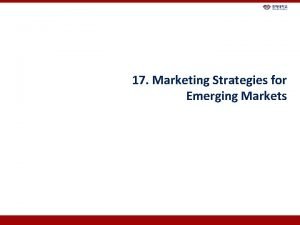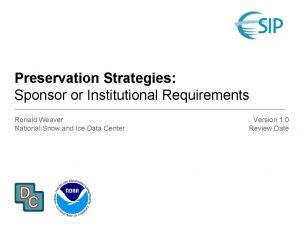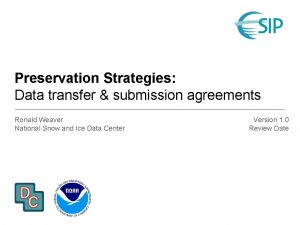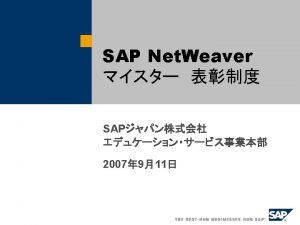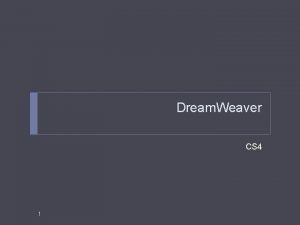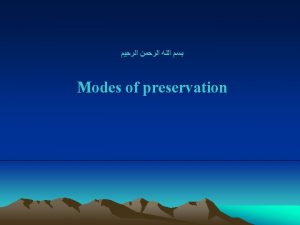Preservation Strategies Emerging standards for preservation Ronald Weaver







- Slides: 7

Preservation Strategies: Emerging standards for preservation Ronald Weaver National Snow and Ice Data Center Version 1. 0 Review Date

Module Template: Subtitle; Version 1. 0, Reviewed 9/15/11 Overview • Many strategies and technologies exist that support data preservation. To the extent possible the data management and data provider communities need to converge on a set of standards that support preservation. Such standardization can increase data discovery, access, and use and reduce costs associated with data preservation • The viewpoint necessary for preservation is distinctly different than that of the active user community. • Preservation implies relevancy and ability to access the data 20 -50 years in the future on systems as yet not developed or conceived and for purposes unimagined.

Module Template: Subtitle; Version 1. 0, Reviewed 9/15/11 Emerging Standards Categories • When we speak of data standards it usually means standards for data access, distribution and preservation • Data Formats: • Metadata: including Digital Object Identifiers (DOI) • Ancillary and supporting data sets used in the production of the data set • Physical Storage:

Module Template: Subtitle; Version 1. 0, Reviewed 9/15/11 Attributes of Standards for Preservation • Data Formats • Wherever possible non-proprietary and open source • Well understood by the appropriate scientific discipline communities • Well documented so that future users (20 -50 years from now) can read the data • Metadata • OAIS compliant • ISO compliant • If neither of the above at least follows common practices of the appropriate scientific communities

Module Template: Subtitle; Version 1. 0, Reviewed 9/15/11 Attributes of Standards for Preservation • Ancillary and supporting data: • Most data sets, especially geophyscial observations are derived from instrument data with ancillary data and calibration information. It is essential that the ancillary data be preserved along with the primary data (instrument) data set • These data need to be described (format, metadate etc. ) to the same level as the primary data • Physical Storage: • Digital data – the ‘bits’ must be stored on physical media and typically the data center migrates media as new systems emerge. • The essential point is that media will change through time and the absolute fidelity of the bit transfer process must be guaranteed and documented

Module Template: Subtitle; Version 1. 0, Reviewed 9/15/11 References and Resources • Several websites offer links to more general data management plan development. We suggest starting with the following: • http: //esipfed. org/resources • Digital Curation Centre Plans (Useful checklist for developing a data management plan) http: //www. dcc. ac. uk/resources/data-management-plans • University of California Curation Center (Data Planning Checklist) http: //www. cdlib. org/services/uc 3/datamanagement/index. html • Data Management and Publishing (MIT) http: //libraries. mit. edu/guides/subjects/data-management/ • Data Management and Publishing (Univ of Minnesota) • http: //www. lib. umn. edu/datamanagement/funding#What 1 • Common internet search terms “data management plan” “earth science data management”

Module Template: Subtitle; Version 1. 0, Reviewed 9/15/11 Other Relevant Modules • List modules that are related
